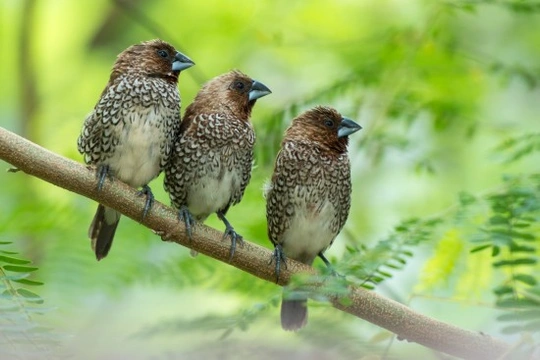
Bengalese, Mannikins and Silverbills
The Bengalese Finch (Lonchura striata domestica), also known as the Society or Social Finch, is another very popular captive bird species. These little finches are part of the Lonchura family which includes mannikins (also known as munias or nuns) and silverbills, but is itself not a bird found in the wild. It is believed the Bengalese is a captive bred mutation of the White rumped Munia or perhaps a cross with another mannikin. Some have suggested it was first bred in China, but it’s true heritage has been lost to time.
Keeping Bengalese
The biggest problem with Bengalese is the sexing of birds. There are no clear differences between male and female birds apart from the male sings, while the female only makes a range of softer noises. When the male sings, he sits upright, making himself as tall as possible, flairs out his tail and sings with all his heart.
These finches come in a wide range of colours and variations all around a theme from white to almost black grey. Common forms are chocolate, fawn, white with red or black eyes, chestnut and shades described as red but are more of a grey colour. Most all birds have white on them in some form.
Feeding Bengalese is uncomplicated; they will happily live on a foreign finch seed mix and enjoy extras such as spray millet and egg food. Most birds will take greens such as cabbage, kale and spinach or nibble at apples or oranges. Access to grit is also important for the calcium element when breeding.
Bengalese are very sociable little finches, as their alternative name suggests. When living in colonies, they will cram into a nesting box at night with the result of a multitude of little faces peering out at you. This endearing trait can be a hindrance when breeding, and it is often found that Bengalese are better bred as single pairs.
Breeding Bengalese
These birds make excellent foster parents and are used by breeders to take eggs or chicks from a variety of other finches. As long as the chick resembles their own in the most basic ways, then Bengalese will usually feed and rear it as if it was theirs.
Bengalese will nest in a finch box, canary nesting pan or anything else they can construct a nest in, though prefer to be covered in. Otherwise, they will spend a lot of time trying to construct a roof, which is a fruitless job with nesting material! They will nest with jute or coconut fibres, discarded feathers, grasses and anything else they come across, even dried greens and flooring materials such as Easibed.
When breeding does occur, 3-9 eggs are laid which are incubated by both parents for around 16 days. The chicks fledge at an age of 19-25 days and are fed by their parents for around 4 weeks. They experience their first moult at 3 months and are sexually mature at this age, though it is advisable to wait longer before allowing them to breed.
Silverbills
There are two species of Silverbill, Indian (Lonchura malabarica) and African (Lonchura cantans). They are easily told apart due to one being mainly a soft brown while the other is a darker brown with cream breast. The two species can cross with no adverse effect. There is a third species of Silverbill in the family, but I do not think it is kept in aviculture in this country, the Grey Headed Silverbill.
As their name suggests, they are from India and Africa respectively and have a bluish-silver beak. They are smaller than Bengalese but otherwise the family resemblance is clear. They can hybridise with Bengalese and others from the Lonchura family.
These are easy-tempered little birds who get on well with others and do not cause particular conflict in a mixed setting. They can be a little nervous in a smaller cage, but this depends on their upbringing. I have found mine are happier in the flight where they can keep a distance from the humans if they require, but some have become tame enough to confidently take food directly from me on occasions.
Mannikins or Munias
There is a whole range of species of mannikins, also known as munias or nuns, some more commonly kept in aviculture in this country than others. Some of the more commonly seen are the scaly breasted mannikin, also known as the Spice Finch, Chestnut Breasted Munias, White headed Munias and Tricolour Munias. They come from a wide range of habitats across Africa, South Asia down to Indonesia and the Philippines.
All the birds are similar in build to Bengalese finches with minor variations. There is a wide range of colours, from black and white to shades of brown and grey. There are no pure white mannikins, but like all birds, sometimes different mutations breed in captivity which may not have survived in the wild. All mannikin species can cross breed with each other, with Silverbills and Bengalese.
Temperament changes from bird to bird, but as a rule, mannikins are quiet and gentle birds who can live well with others. They tend to be more wary of humans than Bengalese but again, this can depend on upbringing.
Different species have different nesting requirements, mostly due to where they are originally from. For instance, the White Headed Munia like to nest in and around bamboo and use the leaves to line their nests. It is always worth checking any special requirements the species has when you are looking to breed.
Conclusion
Bengalese are an excellent start-up bird and the Silverbill and mannikins are not much more difficult to care for. All these finches are the type of bird to sit and watch, enjoy their antics and listen to their songs, rather than interact with their owners. There are challenges with breeding these birds, but nothing that a little research or advice from breeders cannot overcome and, once mastered, they are highly successful parents.



